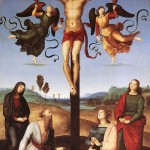Eller, Jack David. Cruel Creeds, Virtuous Violence Prometheus Books, 2010.
I’m going back into chapter one of the book (hopefully to get a draft done by the end of the month), and that means going back into religion and violence. Eller’s book is about the relationship between religion and violence, not only that humans incorporate violence into religion, but that we also invest violence with religious meaning.
Eller includes voluntary and self-inflicted pain and suffering as violence, and discusses self-injury extensively in Chapter 4. There is both literal sacrifice and symbolic sacrifice. In Genesis 22:2, Abraham killed a ram in the place of his son. In Catholic communion, the wine and bread becomes the blood and body of God-in-human-form, to allow a symbolic act of cannibalism.
For my purposes, I’ll focus on non-lethal, voluntary sacrifice against the self.
Arguably, there is no society or religion, including hunter-gatherer socities, that did no practice some form of self-mutilation or self-deprivation for serious religious reasons…. there are so many ways to hurt oneself, from depriving simple comforts like soft beds and normal conversation, to undergoing painful and disfiguring operations, to torturing oneself, to killing oneself or allowing oneself to be killed.
Pg. 117
This wide range includes acts that Westerners have a hard time interpreting as anything other than sexual, as in the case of the Sambia in eastern New Guinea, whose male initiation rites involve men supplying boys with maleness by having the boys perform oral sex. (Pg.125)
Eller distinguishes between self-injurious acts by lay followers and those by ascetics.
The main difference between ascetics and ordinary self-mortifiers is that the former are “professionals,” often “full-time” or official or ordained representatives of the religion; they may, therefore, take on their self-destructive duties more regularly or even permanently, as well as more enthusiastically.
Pg. 133
“Asceticism” comes from the Greek verb askein, meaning “to work/exercise”. (Pg.134) This suggest a purposefulness or intentionality. Asceticism is not merely the absence of pleasure or comfort, but undertaken towards some goal. Max Weber said that asceticism is associated with religions that have a salvation theology, and ascetic practice is a methodical procedure for salvation. (Pg.134)
Christianity is just one of those religions with ascetic traditions, both individual hermits and organized monastic communities. Scholar Piero Camporesi described these practices as “a bloodthirsty butchering of the self” (pg.137)
Hinduism and its offshoot faiths have their own forms of self-sacrifice. Where Christian practice is based on ideas of atoning for original sin, Hindu practice is an attempt to separate oneself from the material world. (Pg. 139)
More generally, self-mortification serves the purposes of emulating the suffering of a divine or ancestral figure, making the self exemplary and closer mentally and emotionally; of enacting ideologies and doctrines (often hatred of the body); achieving altered states of consciousness via many methods, including pain which both releases endorphins and provides hyperstimulation of the sensorium; and in disruption normal perception and heightening awareness. Elaine Scarry says pain overwhelms the conscious mind, allowing an escape from society, from the ordinary. (Cf. Ariel Glukich’s assertion that pain is always interpreted through the mind, through society, but it may create radical alterations in the the mind.) The fundamental idea is spiritual regeneration, the liminality and communitas of Victor Turner’s ritual. “It is training the self, via the body, to feel and respond in certain ways.” (Pg.149) Recreate the self through violence, hopefully of a restrained kind, and you recreate the world.
Through what Thomas Csordas calls “somatic modes of attention,” culturally elaborated ways of attending to and with one’s body in surroundings that include the embodied presence of others, humans learn not only to attend to their body but to attend with their body– a “turning toward,” a conversion, a becoming that is not merely cognitive but visceral.
Pg. 149, emphasis in original
The hitch to all this is that self-mortifiers need not be enlightened people, and can turn out to be very violent, coercive, arrogant and self-righteous people.(Pg.159) The self-directed violence of the ascetic is not completely separate from the other-directed violence of the warrior; both are at war, just with different things. And the altered psychological and social state of war is not unlike that of monastic practice, in that they allow an escape from the mundane. “War is, unfortunately, one source of that transcendent experience, that oceanic feeling, that hyperreality that is associated with art and religion.” (Pg.285)
I would argue that the vivid fantasies of the BDSM culture, the hyperreal worlds of The Story of O and Laura Antoniou’s Marketplace and Anne Rice’s Club in Exit to Eden, and the approximations we strive to create in our bedrooms and nightclubs, provide some of that experience.
Can we uncouple symbolic violence (“play”) from actual violence? Eller quotes anticolonialist activist Frantz Fanon’s ideas of the end of the real violence of colonialism through the spiritual regeneration via the symbolic violence of play and dance:
There are no limits– for in reality your purpose in coming together is to allow the accumulated libido, the hampered aggressivity, to dissolve as in a volcanic eruption. Symbolical killings, fantastic rides, imaginary mass murders– all must be brought out. the evil humors are undammed, and flow away with a din as of molten lava.
Fanon, The Wretched of the Earth, pg. 57, quoted in Eller, Pg. 43
Maybe, maybe not.




Sorry, the comment form is closed at this time.